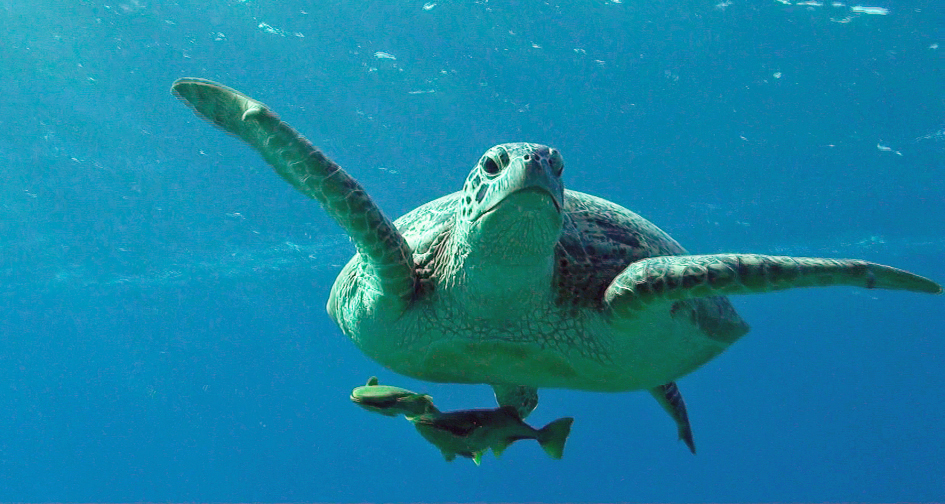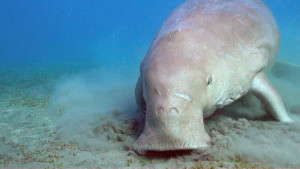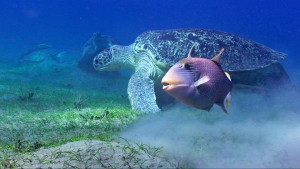Marine Life & Conservation
Marsa Abu Dabab – The Red Sea

As is often the case, we, human beings, find paradise and then proceed to systematically change it in the name of entertainment. We chip away at perfect and pristine ecosystems until they become unrecognisable. Then we pave them over and look for new destinations. Well, we are very close now to having no where else to go. The world has shrunk under our prolific desire to breed, travel and conquer.
There are a few places left, where we can, given the opportunity, see nature in its true form and make great effort to leave it as we found it.
One such place is Marsa Abu Dabab, a quiet and sheltered sandy bay that is home to a resident population of Green Turtles and the frequent Dugong, and is one of my favourite dives in the Red Sea. Yet even this perfect little bay is not pristine, for it has endured the ravages of commercial development, herbicidal run-off, and chemical and biological pollution.
 In January 2007, HEPCA (Hurghada Environmental Protection and Conservation Association), together with its partners, the Red Sea Governorate and the National Parks Authority of Egypt, proposed a management strategy to protect the bay and its inhabitants articulated on the following key actions.
In January 2007, HEPCA (Hurghada Environmental Protection and Conservation Association), together with its partners, the Red Sea Governorate and the National Parks Authority of Egypt, proposed a management strategy to protect the bay and its inhabitants articulated on the following key actions.
Agnese Mancini is a Sea Turtle Biologist with special interest in the bay.
Jeff: How many green turtles actually live in Marsa Abu Dabab?
Agnese: We identified at least 50 different green turtles living in the bay, although they are not there all at the same time. Usually daily sightings go from 15 to 30 individuals. We also found at least 2 hawksbill turtles that are frequently seen feeding or resting on the southern reef.
Jeff: Are they there all year around?
Agnese: Yes, they use the bay all-year round mostly for feeding.
Jeff: Do they mate and lay eggs in the bay as well?
Agnese: We have no evidence that they mate in the bay. As for laying eggs, all the coastline of the Egyptian Red Sea is considered a potential nesting site (especially large sandy beaches), however at present I would say that it is very unlikely for a green turtle to lay eggs in the bay…there is no space left for them to dig nests.
Jeff: Last time I was there at the end of 2012, I saw quite a bit of holiday resort development. Is this causing a significant problem to the ecology of the bay?
Agnese: Coastal development is always a problem, especially in small sheltered bays. In Marsa Abu Dabab for example, we do know that the status of the coral reefs both on northern and southern sides of the bay is in bad condition: you can see pieces of broken corals and dead colonies. Also the sea grass meadows are very sensitive to sediments in the water column (usually decreasing the light penetration) and water quality. Sediments tend to increase when you have a lot of people swimming and/or diving too close to the sand and thus moving a lot of sediments that will end up covering sea grass (marine plants that rely on sunlight to survive).
Jeff; Are the developments regulated at all and is any consideration being given to preserving the area?
Agnese: There are laws protecting the environment in Egypt and developments are required to provide an impact study before any work can be done, especially in sensitive areas like Marsa Abu Dabab. Unfortunately, most of the time money talks.
Jeff; How are the Turtles as well as the other species being affected?
 Agnese: Coastal development can be detrimental for marine species for many reasons: increasing of sediment in the area which bring decreased penetration of light (most marine species, corals for example, need a specific amount of light to survive), changes in the substrate composition, increased disturbance in the water due to the higher number of users, increased noise pollution (again due to boats, zodiacs, people screaming, etc). Coastal developments can also modify the normal patterns of currents and water circulation, although this does not seem the case for Abu Dabab. Another consequence of coastal development is that for example during the rare (but increasing) floods events, all the pesticides and chemicals used in the hotels to appear more “green” are washed away in the bay creating periodical bloom of algae that subsequently kill the sea grass. On a macro-scale, no sea grass means no turtles and no dugongs but on a smaller scale, hundreds of other animals are affected by the absence of sea grass and/or by the higher concentration of chemicals in the water, chemicals that end up accumulating in the sand.
Agnese: Coastal development can be detrimental for marine species for many reasons: increasing of sediment in the area which bring decreased penetration of light (most marine species, corals for example, need a specific amount of light to survive), changes in the substrate composition, increased disturbance in the water due to the higher number of users, increased noise pollution (again due to boats, zodiacs, people screaming, etc). Coastal developments can also modify the normal patterns of currents and water circulation, although this does not seem the case for Abu Dabab. Another consequence of coastal development is that for example during the rare (but increasing) floods events, all the pesticides and chemicals used in the hotels to appear more “green” are washed away in the bay creating periodical bloom of algae that subsequently kill the sea grass. On a macro-scale, no sea grass means no turtles and no dugongs but on a smaller scale, hundreds of other animals are affected by the absence of sea grass and/or by the higher concentration of chemicals in the water, chemicals that end up accumulating in the sand.
Jeff: Have you noticed any significant change in turtle numbers over the last few years?
Agnese: Unfortunately marine turtles and green turtles in particular show naturally very high annual fluctuations in their abundance, so it is very hard with only 2-3 years of data to have an idea of the trend of the population. I personally don’t think that the number of turtles has decreased, but I think the use of the bay is now different: turtles are spending more time in deeper areas that are not used as intensively by snorkelers and divers as the shallow areas.
Jeff: What is HEPCA doing now to protect the area?
Agnese: In January 2007, HEPCA, together with its partners, the Red Sea Governorate and the National Parks Authority of Egypt, proposed a management strategy to protect the bay and its inhabitants articulated on the following key actions:
- Zoning: a new zoning line was secured to prevent motorized boat traffic inside the Bay; moreover, moorings were removed to stop overnight stays by safari boats.
- Access: the bay can be accessed only from shore. The number of visitors (snorkelers or divers) should be carefully controlled and, in addition, safari and daily boats are no longer allowed to send their guests inside the Bay.
- Enforcement: two rangers from the Red Sea Protectorate are to be positioned at Marsa Abu Dabab to ensure these restrictions are met.
- Education: HEPCA and its partners (including the resident Orca Dive Club) have launched an awareness campaign that will help to educate not only visitors to the Red Sea, but also their guides.
- Research: A sighting and mapping project was launched to collect much-needed data about the resident dugong and turtle population for scientific and environmental research.
The management plan however has not been respected. We received reports from the local dive centres of safari boats spending the night in the bay especially during summer months and carrying their guests using zodiacs. The enforcement also is not strong enough and being now 100% private, there is no way to limit or control the number of visitors using the bay.
HEPCA is putting more action in place this year to better protect not only Abu Dabab but also other bays with extensive sea grass meadows.
Jeff: Even before the full scale commercial development started, there were often great numbers of holiday makers snorkelling in the bay and harassing the Turtles in the shallow water. They were doing the same with the Dugongs which of course finally got driven away. Are the Turtles perhaps a little more tolerant than the Dugongs or are they also feeling the pressure?
Agnese: Turtles are definitely more tolerant to human harassment than the dugong. In Abu Dabab in particular, they got used to the increasing number of people in the water and most of the time, turtle reaction to a wrong behaviour would be to swim further out in deeper area to get rid of the annoying people trying to touch it. This is true for older (and thus bigger) turtles. Younger individuals are much more sensitive to human presence and harassment; if they feel unsafe they will simply move to another bay.
Jeff: I know there have been a few online petitions created to protest about over-development. Have they had any effect at all? Is it worth divers getting involved on any level to protect the bay?
Agnese: Of course it is worth divers getting involved to promote protection of the bay! Divers and other users together with NGOs and local authorities are those that can actually push for change to happen and for implementation of new laws.
Jeff: What are the consequences of loosing the bay as it is and loosing all the species that live there?
Agnese: Losing Marsa Abu Dabab would mean losing one of the most amazing feeding grounds for green turtles (which, by the way, are a worldwide endangered species) and dugongs. It would mean losing one of the most valuable natural treasures of the Egyptian Red Sea. Once a site like this is lost, it will be probably be lost forever.
Jeff: If the Turtles were to be driven away, where would they go? Where else is left where food is abundant and the pressures of tourism is minimal?
Agnese: There are other bays with extensive sea grass meadows (for example Marsa Shoni, Marsa Imbarak) but they all have the same problem: a lot of people going there, a lot of boats and zodiacs, no rules. The only pristine areas left are probably in the southern end of the Egyptian Red Sea (wadi Gemal national park and Shalateen area).
You can view Jeff Goodman’s short film on the Turtles at http://www.youtube.com/watch?v=DS0YOnPU1w8&list=UUKfpZWTCn_SdaILHrx5HRvg&index=34
And sign a petition at http://mgste.epetitions.net/
If you would like to know more about the issues in this article or more about HEPCA please go to www.hepca.org or contact Agnese at: agnese@hepca.org
Blogs
Invitation from The Ocean Cleanup for San Francisco port call

6 years ago, The Ocean Cleanup set sail for the Great Pacific Garbage Patch with one goal: to develop the technology to be able to relegate the patch to the history books. On 6 September 2024, The Ocean Cleanup fleet returns to San Francisco bringing with it System 03 to announce the next phase of the cleanup of the Great Pacific Garbage Patch and to offer you a chance to view our cleanup system up-close and personal.
We look forward to seeing you there.
To confirm your presence, please RSVP to press@theoceancleanup.com
PROGRAM
Join The Ocean Cleanup as our two iconic ships and the extraction System 03 return to San Francisco, 6 years and over 100 extractions after we set sail, to create and validate the technology needed to rid the oceans of plastic.
Our founder and CEO, Boyan Slat, will announce the next steps for the cleanup of the Great Pacific Garbage Patch. Giving you a chance to view our cleanup system and the plastic extracted.
Hear important news on what’s next in the mission of The Ocean Cleanup as it seeks to make its mission of ridding the world’s oceans of plastic an achievable and realistic goal.
Interviews and vessel tours are available on request.
PRACTICALITIES
Date: September 6, 2024
Press conference: 12 pm (noon)
Location: The Exploratorium (Google Maps)
Pier 15 (Embarcadero at Green Street), San Francisco, CA
Parking: Visit The Exploratorium’s website for details.
RSVP: press@theoceancleanup.com
Video & photo material from several viewing spots around the bay
We look forward to seeing you there!
ABOUT THE OCEAN CLEANUP
The Ocean Cleanup is an international non-profit that develops and scales technologies to rid the world’s oceans of plastic. They aim to achieve this goal through a dual strategy: intercepting in rivers to stop the flow and cleaning up what has already accumulated in the ocean. For the latter, The Ocean Cleanup develops and deploys large-scale systems to efficiently concentrate the plastic for periodic removal. This plastic is tracked and traced to certify claims of origin when recycling it into new products. To curb the tide via rivers, The Ocean Cleanup has developed Interceptor™ Solutions to halt and extract riverine plastic before it reaches the ocean. As of June 2024, the non-profit has collected over 12 million kilograms (26.4 million pounds) of plastic from aquatic ecosystems around the world. Founded in 2013 by Boyan Slat, The Ocean Cleanup now employs a broadly multi-disciplined team of approximately 140. The foundation is headquartered in Rotterdam, the Netherlands, and opened its first regional office in Kuala Lumpur, Malaysia, in 2023.
Find out more about The Ocean Cleanup at www.theoceancleanup.com.
Marine Life & Conservation
SHARK MONTH ARRIVES AT ROYAL WILLIAM YARD, PLYMOUTH

A shark has been spotted approaching Royal William Yard in Plymouth, much to the surprise of swimmers, paddleboarders and onlookers.
With its distinctive dorsal fin cutting through the water, the sizeable shark swam along the coastline, before turning to head inland towards Firestone Arch at Royal William Yard. The appearance drew a crowd, who were captivated for more than an hour by the unusual sight – and it was all caught on video.
The shark is one of many expected sightings at Royal William Yard over the coming weeks… because today marks the start of Shark Month!
In reality, the ‘shark’ spotted along the Plymouth shoreline was actually a custom-made model, created by the team at Royal William Yard and sailed underwater by Caroline Robertson‑Brown from the Shark Trust, who donned scuba diving gear for the occasion.
The stunt took place to launch Shark Month in style and draw attention to the work of the leading international conservation charity, which is based in Britain’s Ocean City. Spectators were reassured that the water was safe and many entered into the spirit of the performance, swimming or sailing alongside the shark.
Shark Month will take place across Royal William Yard throughout July and will feature an extravaganza of art, entertainment and advocacy for everyone to enjoy. The packed programme of events starts with an art exhibition and ends with a trip on paddleboards with shark experts – with everything from a shark quiz to a Jaws screening in between.
Paul Cox, CEO of the Shark Trust, said: “There are often assumptions and misconceptions when it comes to sharks. This was certainly the case with the shark spotted at Royal William Yard! While the British coastline is home to many species of shark, this was not one of them. However, we’re thrilled it caught people’s attention, because seeing a shark is a special and memorable moment. That is precisely why we want to celebrate these incredible creatures, highlight the need for conservation, and ask for help to safeguard their future.”
For more information about Shark Month at Royal William Yard, visit the Shark Trust Website.
Images and video: Jay Stone
-

 Blogs2 months ago
Blogs2 months agoDiving With… Nico, Ocean Earth Travels, Indonesia
-

 News1 month ago
News1 month agoMurex Bangka Announce New Oceanfront Cottages & Beachfront Dining
-

 Blogs2 months ago
Blogs2 months agoA new idea in freediving from RAID
-

 Marine Life & Conservation1 month ago
Marine Life & Conservation1 month agoIceland issue millionaire whale hunter a licence to murder 128 vulnerable fin whales
-

 Marine Life & Conservation2 months ago
Marine Life & Conservation2 months agoThe Shark Trust Great Shark Snapshot is back
-

 News3 months ago
News3 months agoCharting New Waters; NovoScuba Goes Global with the Launch of their Revolutionary Dive Training Agency!
-

 Gear News1 month ago
Gear News1 month agoNew Suunto Ocean – a dive computer and GPS sports watch in one for adventures below and above the surface
-

 Marine Life & Conservation Blogs2 months ago
Marine Life & Conservation Blogs2 months agoBook Review: Plankton




